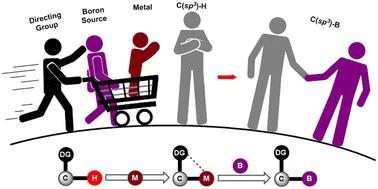当前位置:
X-MOL 学术
›
Catal. Sci. Technol.
›
论文详情
Our official English website, www.x-mol.net, welcomes your feedback! (Note: you will need to create a separate account there.)
Substrate-directed C(sp3)–H borylation via transition metal catalysis: expanding the toolbox for C–H functionalization
Catalysis Science & Technology ( IF 4.4 ) Pub Date : 2024-08-05 , DOI: 10.1039/d4cy00754a Dolly David Thalakottukara 1 , Manikandan Sekar 1 , Astam Mandal 2 , Thirumanavelan Gandhi 1 , Debabrata Maiti 2
Catalysis Science & Technology ( IF 4.4 ) Pub Date : 2024-08-05 , DOI: 10.1039/d4cy00754a Dolly David Thalakottukara 1 , Manikandan Sekar 1 , Astam Mandal 2 , Thirumanavelan Gandhi 1 , Debabrata Maiti 2
Affiliation

|
Organoborons play a crucial role in organic synthesis, easing the construction of C–C and C–X bonds, which in turn sensitize C–H borylation reactions. In the context of inert C(sp3)–H borylation, significant efforts have been dedicated to achieve site- and chemoselectivity by involving directing groups via transition metal catalysis. This review highlights various types of directing groups that can enable intricate and distal C(sp3)–H borylation; heteroatoms such as P, N, B, Si, Br, O, and Cl, which are attached to the substrate, act as the directing group. In addition to homogeneous catalysis, the occurrence of heterogeneous catalysis was realized, and the considerable contribution to chiral C(sp3)–H borylation is discussed. Finally, this review summarizes the mechanistic aspects and late-stage modifications of complex molecules.
中文翻译:

通过过渡金属催化进行底物导向的 C(sp3)–H 硼化:扩展 C–H 功能化的工具箱
有机硼在有机合成中发挥着至关重要的作用,可以简化 C-C 和 C-X 键的构建,从而使 C-H 硼化反应变得敏感。在惰性 C(sp 3 )–H 硼基化的背景下,人们致力于通过过渡金属催化引入导向基团来实现位点选择性和化学选择性。这篇综述重点介绍了可以实现复杂且远端的 C(sp 3 )–H 硼化的各种类型的导向基团;连接到基底上的杂原子,如 P、N、B、Si、Br、O 和 Cl,充当导向基团。除了均相催化外,还实现了多相催化的发生,并讨论了对手性 C(sp 3 )–H 硼基化的重要贡献。最后,这篇综述总结了复杂分子的机制方面和后期修饰。
更新日期:2024-08-05
中文翻译:

通过过渡金属催化进行底物导向的 C(sp3)–H 硼化:扩展 C–H 功能化的工具箱
有机硼在有机合成中发挥着至关重要的作用,可以简化 C-C 和 C-X 键的构建,从而使 C-H 硼化反应变得敏感。在惰性 C(sp 3 )–H 硼基化的背景下,人们致力于通过过渡金属催化引入导向基团来实现位点选择性和化学选择性。这篇综述重点介绍了可以实现复杂且远端的 C(sp 3 )–H 硼化的各种类型的导向基团;连接到基底上的杂原子,如 P、N、B、Si、Br、O 和 Cl,充当导向基团。除了均相催化外,还实现了多相催化的发生,并讨论了对手性 C(sp 3 )–H 硼基化的重要贡献。最后,这篇综述总结了复杂分子的机制方面和后期修饰。





































 京公网安备 11010802027423号
京公网安备 11010802027423号